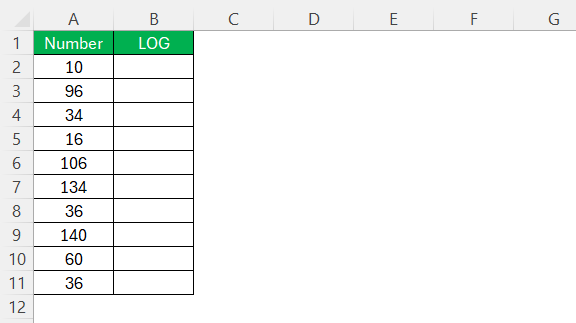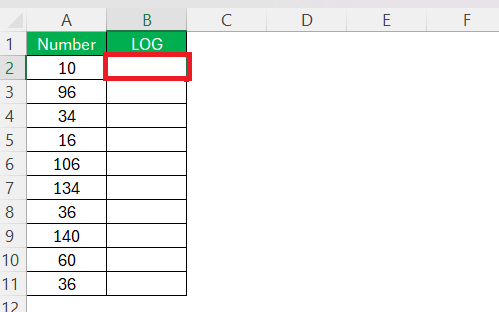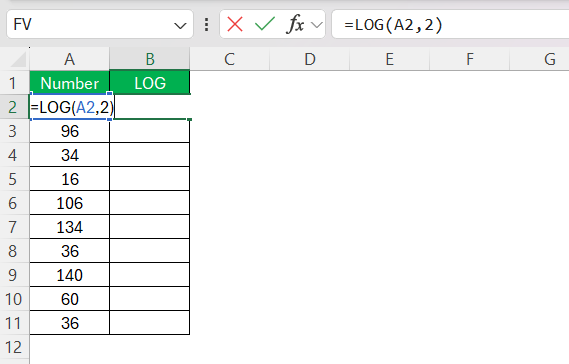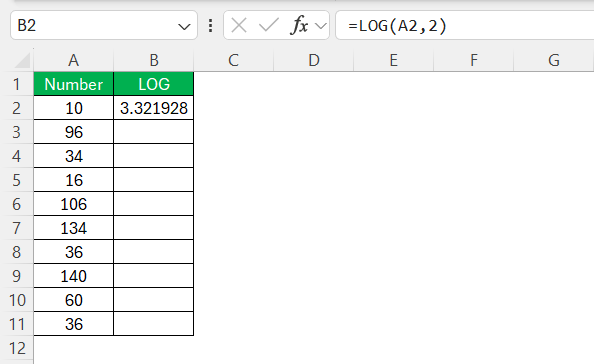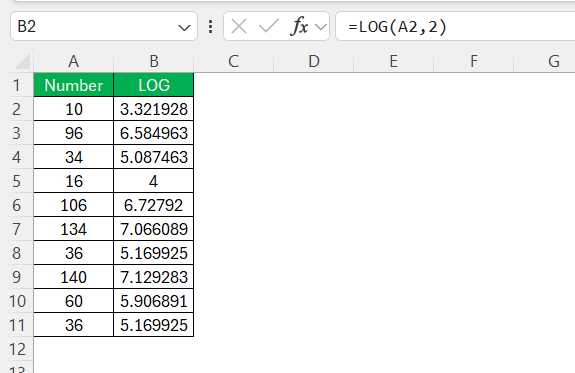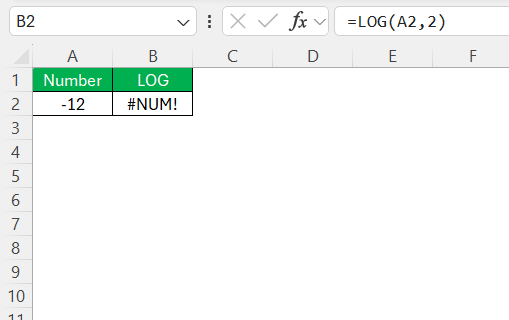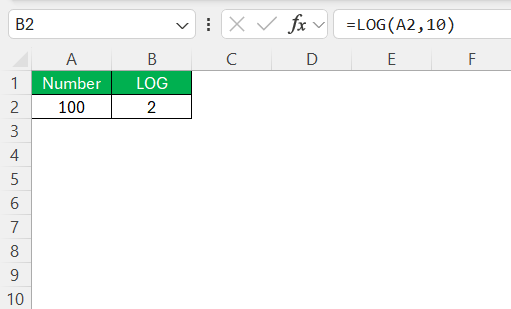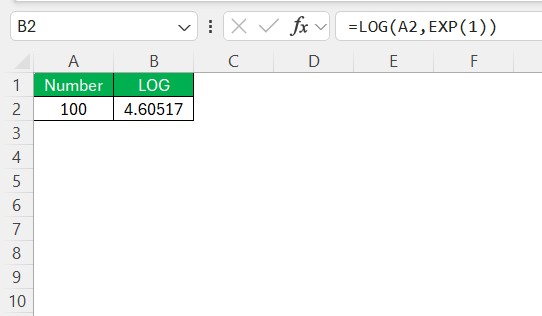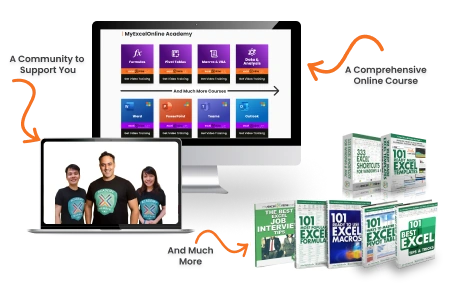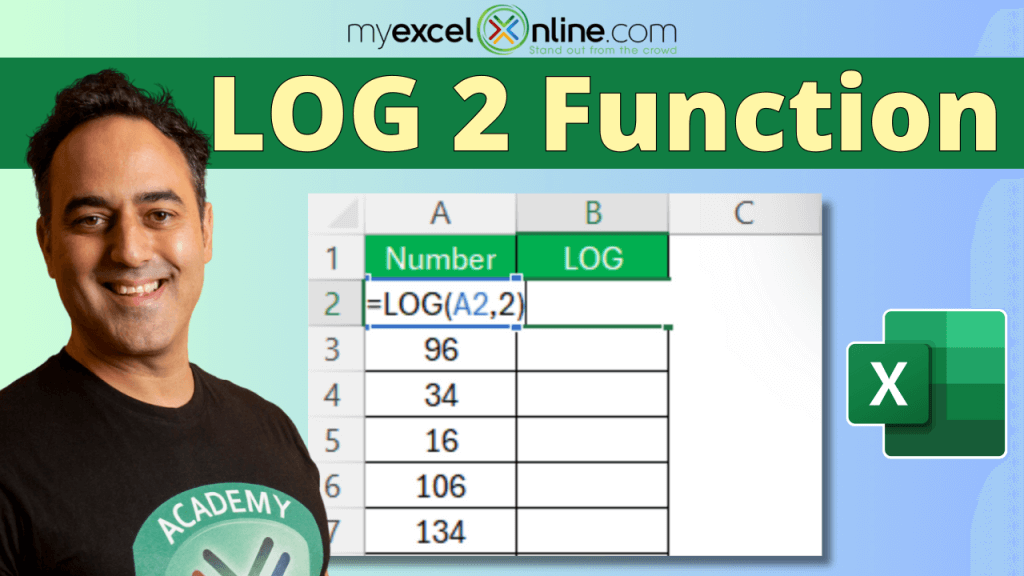
LOG function defaults to base 10, many users assume there’s no direct way to compute log base 2. However, with a simple trick, Excel makes it easy to perform these calculations. In this article, I’ll guide you through different methods to find log 2 in Excel.
Key Takeaways:
- Excel’s LOG function allows custom bases, making it easy to compute log base 2 with =LOG(number, 2).
- Log base 2 is useful in binary-related calculations, particularly in computer science and financial modeling.
- Using cell references instead of hardcoded numbers enhances accuracy and adaptability in logarithmic computations.
- Common errors include using negative numbers or missing the base argument, which can lead to incorrect results.
- Antilog calculations help reverse logarithmic transformations, restoring original values with =POWER(2, log_value).
Table of Contents
Understanding the Log 2 Function
Defining the Logarithm Concept
Logarithms provide a method to express complex numbers as exponents, making them easier to compute with. Imagine them as a tool converting sprawling mathematical equations into manageable numbers. The basic idea is to find which power a base number must be raised to, to produce another number. For example, if 2 raised to the power of x equals 8, the logarithm tells us that x is 3 (since (2^3 = 8)).
Known for transforming multiplicative relationships into additive ones, logarithms have revolutionized various scientific fields since their inception in the 17th century. Their ability to turn grand, unwieldy numbers into compact figures ensures their enduring relevance in calculations and data analysis tasks across multiple domains.
Specifics of Base-2 Logarithms in Excel
Base-2 logarithms, often termed binary logarithms, are crucial in fields like computer science, where data operates extensively in binary systems. In Excel, the base-2 logarithm function, or Log 2 function, allows users to transform values into a binary exponential form, facilitating various computations involving binary data. This special functionality is not only limited to computer sciences but also finds its strengths in complex mathematical and algorithmic calculations.
The function itself is simple to apply in Excel: by using the specifically crafted formula =LOG(number, 2), computations on binary bases become straightforward, providing users with precise results efficiently. This function is particularly powerful when you need to work with exponential growth scenarios or when breaking down complex data sets into simpler binary components. By using the Log 2 function, Excel users can streamline data processing tasks and enhance data interpretation strategies significantly.
How to Use the Log 2 Function in Excel
Step-by-Step Guide
Mastering the Log 2 function in Excel is straightforward with a structured approach. Here’s a step-by-step guide to help you leverage this function efficiently:
STEP 1: Ensure that your data is organized and the cell where you plan to place the Log 2 calculation is ready.
STEP 2: Click on the cell where you want to display the Log 2 result.
STEP 3: Type the formula =LOG(number, 2). Replace “number” with the cell reference or the actual number you wish to calculate the base-2 logarithm for. For instance, if you want to compute the base-2 logarithm of the number 10, you would type =LOG(10, 2).
STEP 4: Once you have entered the formula, hit the Enter key. Excel will immediately compute the result and display it in the selected cell.
STEP 5: If you need to apply the same base-2 logarithmic calculation across multiple numbers, you can drag the fill handle (a small square at the bottom-right corner of the cell) to copy the formula to adjacent cells.
By following these steps, you will be able to seamlessly calculate base-2 logarithms across a range of values, simplifying the complexity of binary computations in Excel. This process assists in efficiently managing data that requires binary representation, enabling precise and optimized data analysis.
Best Practices for Accurate Results
To achieve accurate results with the Log 2 function in Excel, consider implementing the following best practices:
- Verify Data Accuracy: Before applying the function, ensure that all numerical data is correctly entered. Check for typos or inaccuracies, as these can lead to unexpected outcomes in your calculations.
- Specify the Correct Base: Always include the base when using the log function. For base-2 logarithms, ensure you use
=LOG(number, 2). This prevents Excel from defaulting to base-10 when no base is specified. - Use Cell References: Instead of manually entering numbers into the formula, use cell references. This practice not only minimizes the risk of errors but also makes your worksheet more dynamic, as updates to the data automatically adjust the results.
- Employ Proper Syntax: Pay attention to the syntax of the formula. A small mistake like a missing parenthesis can disrupt your calculations. Double-check your formula structure before finalizing the entry.
- Audit Results: After computing the logarithms, verify a few results manually or using a calculator to ensure the function is operating as expected. This serves as a cross-check to catch any errors early.
By adhering to these best practices, you can significantly improve the accuracy and reliability of your logarithmic calculations in Excel. This not only enhances data integrity but also ensures that your results are consistently precise and trustworthy, contributing to more informed decision-making based on sound data analysis.
Practical Examples
Applying Log 2 in Financial Analysis
The Log 2 function can be a powerful ally in financial analysis, especially when evaluating exponential growth scenarios or assessing the scalability of financial models. Its application allows for a nuanced interpretation of data, which is essential in making informed investment decisions and financial forecasts.
- Analyzing Compound Growth: Use the Log 2 function to determine growth rates over time by examining how investments double. For instance, if you need to calculate the number of periods it takes for an investment to double, the formula can offer insights that empower strategic planning.
- Mix and Match with Other Formulas: Incorporate the Log 2 function within broader financial models. By doing so, you can calculate returns on investments or measure the effect of compounding interest in situations where binary growth models apply.
- Evaluate Large Data Sets: In financial scenarios where multiple datasets converge, the Log 2 function helps synthesize these into interpretable formats. By transforming exponential growth data into more manageable figures, it aids financial analysts in spotting trends and making predictions.
- Enhancing Portfolio Management: Consider using the function to assess hypothetical scenarios of investment behavior. This allows for testing assumptions, thus refining portfolio strategies by understanding the potential doubling time of assets.
By integrating the Log 2 function into financial analysis, you can refine your approach to understanding asset growth and investment dynamics. This function enables analysts to interpret complex financial data through a binary lens, aiding in strategic decision-making and bolstering analytical capabilities. Whether you’re evaluating the performance of a specific stock or projecting the long-term growth of a portfolio, the Log 2 function offers a robust tool for enhancing financial insight and foresight.
Error Checks and Troubleshooting
Even with all your newfound knowledge, there might still be times when the Log 2 function doesn’t behave as expected. Here’s how to troubleshoot common issues:
- Ensure the number is positive: Logarithms for negative numbers are undefined.
- Check your base: Ensure the base is set to 2; for custom bases, it must be greater than zero.
- Correct Base Use: Verify you’ve used the correct base. Mixing up bases in various cells can lead to inconsistent results, especially when handling diverse data sets.
Troubleshooting is a standard part of working with Excel, so don’t be discouraged. The more you practice and familiarize yourself with these common issues, the more adept you’ll become at quickly identifying and resolving them. Remember, even seasoned Excel users encounter errors, especially with complex formulas. By methodically approaching problem-solving with checks and verifications, you’ll enhance your efficiency and confidence in using the Log 2 function effectively.
Related Functions
Comparing LOG with LOG10
Understanding the differences between the LOG and LOG10 functions in Excel is essential for choosing the right tool for your analytical needs. Both functions compute logarithms, but they cater to different bases which can significantly affect their application.
The LOG function is versatile, allowing users to specify any base for the logarithmic calculation. It follows the syntax =LOG(number, base), where you choose the ‘base’ to suit your specific needs. This flexibility makes it ideal for scenarios where non-standard bases are required, such as when analyzing growth patterns over a specific scale or time frame.
On the other hand, the LOG10 function is specifically designed for base-10 logarithms, known as common logarithms. Its simpler syntax, =LOG10(number), eliminates the need to specify the base each time, making it a convenient choice for applications traditionally associated with base-10, such as scientific notation and standard data scaling processes.
In essence, while the LOG function offers the flexibility to define various bases, the LOG10 function serves as a handy shortcut for operations based strictly on base 10. Choosing between them depends on your specific requirements: if working with diverse bases, LOG is appropriate; for naturally base-10 scenarios, LOG10 provides simplicity and ease.
Exploring Antilog Value Calculation
Calculating antilogs is the reverse operation of finding logarithms, effectively ‘undoing’ the log transformation to return to the original number. This process is crucial in data analysis, especially when data needs to be interpreted on its original scale after logarithmic transformation.
In Excel, the formula =10^A2 can be used to compute base-10 antilogs, where A2 holds the logarithmic value. For other bases, the formula =POWER(base, exponent) is used; replace “base” with the desired base and “exponent” with the logarithmic value. This approach provides flexibility when dealing with special cases that require bases other than 10.
For natural logarithms, which use the constant ‘e’ as the base, the function =EXP(cell) simplifies finding antilogs. It automatically calculates the antilog for the value in the specified cell using the mathematical constant e, streamlining calculations for naturally occurring exponential data trends.
Common errors during these calculations include using non-numeric inputs or negative values which can lead to wrong interpretations. Therefore, implementing careful data checks before processing ensures accurate antilog computations, facilitating clear data interpretation and comparison.
FAQs
How to use log2 in Excel?
To calculate log base 2 in Excel, use the formula =LOG(number, 2). Replace “number” with the cell reference or the actual number you want to calculate the logarithm for. This will provide the logarithm of the number using base 2.
Why use Log 2 over other logarithmic bases?
Log 2 is particularly useful in computing and data science because it aligns with binary systems. It simplifies calculations involving bit operations, data storage, and processing speed evaluations, making it ideal where binary data manipulation is common.
Can I automate Log 2 calculations in Excel?
Yes, you can automate Log 2 calculations using Excel’s drag-and-fill feature. Enter =LOG(cell, 2) for one cell and use the fill handle to drag the formula across other cells, seamlessly applying the Log 2 calculation to an entire range.
How do I find the inverse of log?
To find the inverse of a log, or antilog, use the formula =POWER(base, exponent) in Excel. Replace “base” with the base used in the logarithm and “exponent” with the logarithmic value you want to reverse. This operation will return the original number.
- Suggestions: Suggestion 1: Include a step-by-step example demonstrating how to find the inverse of a logarithm using a common base such as 10, with Excel screenshots for clarity.
- Suggestion 2: Add a brief explanation of what a logarithm and an antilogarithm are, including their applications in real-world scenarios to provide context for the reader.
- Suggestion 3: Incorporate a table comparing different bases (e.g., natural log, base 10, base 2) and their usage, highlighting when and why each might be used.
What is the log function in Excel?
The LOG function in Excel calculates the logarithm of a given number to a specified base. Its syntax is =LOG(number, [base]). If no base is specified, Excel assumes base 10 by default. This function is widely used in data analysis and scientific calculations.
John Michaloudis is a former accountant and finance analyst at General Electric, a Microsoft MVP since 2020, an Amazon #1 bestselling author of 4 Microsoft Excel books and teacher of Microsoft Excel & Office over at his flagship MyExcelOnline Academy Online Course.

